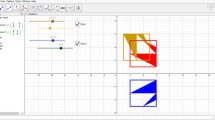ABSTRACT
This paper aims to contribute to discussions on the multimodal nature of cognition through an elaboration of the ways multimodal aspects of thinking are exploited by learners doing mathematics. Moving beyond the fact that multimodality occurs, this paper focuses on how it occurs, with particular attention drawn to the complex network of perceptual, bodily and imaginary experiences of students. Through an analysis of 2 selected episodes of the work of 1 primary school child learning to graph motion, the paper shows how the notion of blending spaces is central to understanding the mechanism of multimodality.
Similar content being viewed by others
References
Ainley, J. (2000). Transparency in graphs and graphing tasks: An iterative design process. Journal of Mathematical Behavior, 19, 365–384.
Arzarello, F., Paola, D., Robutti, O. & Sabena, C. (2009). Gestures as semiotic resources in the mathematics classroom. Educational Studies in Mathematics, 70(2), 97–109.
Burbules, N. C. (2006). Rethinking the virtual. In J. Weiss, J. Nolan, J. Hunsinger & P. Trifonas (Eds.), The international handbook of virtual learning environments (pp. 37–58). Dordrecht, The Netherlands: Springer.
Cobb, P. (2000). Conducting teaching experiments in collaboration with teachers. In A. E. Kelly & R. Lesh (Eds.), Handbook of research design in mathematics and science education (pp. 307–333). Mahwah, NJ: Lawrence Erlbaum.
de Freitas, E. & Sinclair, N. (2012). Diagram, gesture, agency: Theorizing embodiment in the mathematics classroom. Educational Studies in Mathematics, 80(1–2), 133–152.
diSessa, A., Hammer, D., Sherin, B. & Kolpakowski, T. (1991). Inventing graphing: Meta-representational expertise in children. Journal of Mathematical Behavior, 10, 117–160.
Edwards, C. H. (1979). The historical development of the calculus. New York: Springer.
Ferrara, F. (2006). Remembering and imagining: Moving back and forth between motion and its representation. In J. Novotná, H. Moraová, M. Krátká & N. Stehlíková (eds.), Proceedings of the 30th Conference of the International Group for the Psychology of Mathematics Education (vol. 3, pp. 65–72). Prague, Czech Republic: Charles University, Faculty of Education.
Gallese, V. & Lakoff, G. (2005). The brain’s concepts: The role of the sensory-motor system in conceptual knowledge. Cognitive Neuropsychology, 22(3/4), 455–479.
Goldin-Meadow, S. (2003). Hearing gesture: How our hands help us think. Cambridge, MA: Harvard University Press.
Kress, G. (2004). Reading images: Multimodality, representation and new media. Information Design Journal, 12(2), 110–119.
Lakoff, G. & Núñez, R. (2000). Where mathematics comes from. New York: Basic Books.
McNeill, D. (Ed.). (2000). Language and gesture: Window into thought and action. Cambridge: Cambridge University Press.
Nemirovsky, R. (2003). Three conjectures concerning the relationship between body activity and understanding Mathematics. In N.A. Pateman, B.J. Dougherty, & J.T. Zilliox (Eds.), Proceedings of 27th Conference of the International Group for the Psychology of Mathematics Education (vol. 1, pp. 105–109). Honolulu, HI: University of Hawai’i.
Nemirovsky, R. & Ferrara, F. (2009). Mathematical imagination and embodied cognition. Educational Studies in Mathematics, 70(2), 159–174.
Nemirovsky, R., Rasmussen, C., Sweeney, G. & Wawro, M. (2012). When the classroom floor becomes the complex plane: Addition and multiplication as ways of bodily navigation. The Journal of the Learning Sciences, 21(2), 1–37.
Nemirovsky, R., Tierney, C. & Wright, T. (1998). Body motion and graphing. Cognition and Instruction, 16(2), 119–172.
Radford, L. (2009). Why do gestures matter? Sensuous cognition and the palpability of mathematical meanings. Educational Studies in Mathematics, 70(2), 111–126.
Radford, L., Edwards, L. & Arzarello, F. (2009). Beyond words. Educational Studies in Mathematics, 70(2), 91–95.
Rizzolatti, G., Fadiga, L., Fogassi, L. & Gallese, V. (1997). The space around us. Science, 277, 190–191.
Roth, W. M. (2009). Bodily experience and mathematical conceptions: From classical views to a phenomenological reconceptualization. Educational Studies in Mathematics, 70(2), 175–189.
Rotman, B. (2008). Becoming beside ourselves: The alphabet, ghosts, and distributed human beings. Durham: Duke University Press.
Schiralli, M. & Sinclair, N. (2003). A constructive response to ‘where mathematics comes from’. Educational Studies in Mathematics, 52(1), 79–91.
Seitz, J. A. (2000). The bodily basis of thought, new ideas in psychology. An International Journal of Innovative Theory in Psychology, 18(1), 23–40.
Sinclair, N. & Armstrong, A. (2011). A geometric approach to story graphs and piecewise linear functions. Mathematics Teaching in the Middle School, 16(6), 347–353.
Sinclair, N., de Freitas, E. & Ferrara, F. (2013). Virtual encounters: The murky and furtive world of mathematical inventiveness. ZDM The International Journal on Mathematics Education, 45(2), 239–252.
Streeck, J. & Mehus, S. (2005). Microethnography: The study of practices. In K. L. Fitch & R. E. Sanders (Eds.), Handbook of language and social interaction (pp. 381–404). Mahwah, NJ: Lawrence Erlbaum Associates.
Wilson, M. (2002). Six views of embodied cognition. Psychonomic Bulletin & Review, 9(4), 625–636.
Author information
Authors and Affiliations
Corresponding author
Rights and permissions
About this article
Cite this article
Ferrara, F. HOW MULTIMODALITY WORKS IN MATHEMATICAL ACTIVITY: YOUNG CHILDREN GRAPHING MOTION. Int J of Sci and Math Educ 12, 917–939 (2014). https://doi.org/10.1007/s10763-013-9438-4
Received:
Accepted:
Published:
Issue Date:
DOI: https://doi.org/10.1007/s10763-013-9438-4




